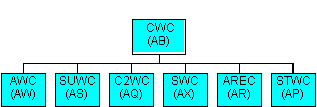
OS-505 -- US Navy
LESSON OBJECTIVES
505.1 Comprehend the capabilities and limitations of US military forces
[I.1(a)].
505.11 Describe the roles and missions of the US Navy.
MISSION: To be organized, trained, and equipped primarily for prompt and sustained combat, incident to operations at sea. (Title 10 USC)
ROLES: (1) Strategic Deterrence, (2) Forward Presence, (3) Power Projection, (4) Sea Control/Maritime Supremacy, (5) Strategic Sea Lift (FORWARD … FROM THE SEA)
JOINT ROLE: "Enable and Support the campaign ashore."
505.12 Describe the organization of the US Navy. (Battlegroup according to Maj Williams of ACSC)
The Battlegroup uses a system called the COMPOSITE WARFARE COMMANDER (CWC) CONCEPT to exercise command and control. The roles are as follows:
CWC (AB) - The Admiral in charge of the group (0-7/8 with staff on the carrier)
AWC (AW) - The Air Warfare Commander (0-6 on an AEGIS Cruiser)
SUWC (AS) - The Surface Warfare Commander (0-6 CO on the Carrier)
C2WC (AQ) - The C2 Warfare Commander (0-5 on the Battelgroup staff)
SWC (AX) - The Subsurface Warfare Commander (0-6 staff on the carrier)
STWC (AP) - The Strike Warfare Commander (0-6 CVW Commander on carrier)
AREC (AR) - The Air Element COORDINATOR (0-6 CO on the carrier )

505.13 Describe the capabilities, composition, and missions of a carrier
battlegroup
CAPABILITIES: Just look at the missions of the Navy and you have it. C4I,
Battlespace Dominance, Power Projection, Force Sustainment. A CVBG can do them all. The
Battlegroup is made up of: (generally)
505.14 Describe the expeditionary capabilities of the US Navy.
Recommend you look at tool book for this section
Key EXPEDITIONARY capabilities of the navy are C4I, Battlespace Dominance, Power
Projection, and Force Sustainment. These fall into the roles and missions of the Navy.
It should be remembered that every ship in the U.S. Navy is sovereign US territory and
therefore does not need permission to operate in international waters.
"EXPIDETIONARY" implies a mind-set, a culture, and a commitment to forces that
are designed to be deployed forward and to respond swiftly. 0FORWARD … FROM THE SEA)
505.2 Comprehend the relationship between Service doctrine and joint doctrine
[I.2(d)].
505.21 Describe the current doctrines in use by the US Navy in support of
the National Security and National Military Strategies and objectives.
There are six volumes that have been promulgated by the Navy Doctrine Command
(NAVDOCCOM) since its establishment in 1992. The Navy recognized that future operations were going to be in the littoral (big surprise) and that they would be joint. (HASTINGS) The doctrine publications developed are:
505.22 Explain how the Navy envisions the employment of naval forces in
support of a theater campaign/operation today.
The most important role of naval forces in situations short of war is to be engaged in
forward areas, with the objectives of preventing conflicts and controlling crises. Building
on the normally deployed forces, we can mass, if the situation requires, multiple
aircraft carrier battle groups into carrier battle forces, amphibious ready groups with
embarked Marine expeditionary units, and as needed project our naval expeditionary forces
ashore using the afloat maritime pre-positioning force. Such a massing of naval units can
be complimented by the deployment of Army and Air Force units to provide a joint force
capable of the full range of combat operations that may be required. (FORWARD … FROM
THE SEA)
505.23 Explain how the Navy envisions the employment of naval forces in
support of a theater campaign/operation in the future.
The new direction for the naval service remains focused on our ability to project power from the sea in the critical littoral regions of the world. (FORWARD … FROM THE SEA)
In the event of a future regional conflict, US naval forces will assume critical roles
in the projection of vital sealift along the strategic lines of approach to the theater of
conflict, including the airports and seaports of debarkation. Our success in a major
regional contingency will depend upon the delivery of heavy equipment and the resupply of
major ground and air elements engaged forward. Sealift is the key to force sustainment for
joint operations. (FORWARD … FROM THE SEA)
Read "Forward ... From the Sea
1. Comprehend the capabilities and limitations of US military forces across the range
of military operations, to include command relationships, force development and
organization, and the concepts of deployment, employment, sustainment, and redeployment
(OPMEP Learning Area).
READINGS
OPTIONAL READINGS (non-testable material): None
READING RATIONALE
The Navy toolbook lays the foundation for US Navy doctrine and outlines the principles upon which the Navy/Marine Corps team organizes, trains, equips, and employs naval forces. The Navy toolbook also provides information on the capabilities, composition, and missions of the carrier battlegroup and Naval Expeditionary Forces. The "Forward ... From the Sea" white paper discusses the basic strategy and directions to be followed by the Navy/Marine Corps team as they prepare for service in the 21st century. Admiral Dur's article reviews the requirements for forward presence in support of the National Security Strategy and discusses the options available. It also emphasizes the flexibility and sustainability of naval forces to meet our nation's forward presence commitments. The Hastings article reviews the history of US Navy doctrine and provides a sailor's view of the importance of developing and effectively promulgating this doctrine to be on par with the other Services.
LESSON OUTLINE
Thesis: United States Navy forces provide the National Command Authority and theater commanders with unique capabilities for rapid and prolonged response to a wide variety of crises. Full understanding of the roles, functions, capabilities, and doctrines of the US Navy is essential to joint staff operational and campaign planners in responding to regional crises that arise.
Main Point I: Review and discuss the roles, functions, capabilities, and doctrine used by the US Navy to support the National Security Strategy, National Military Strategy, and theater commanders.
Main Point II: Review and discuss the future roles, missions, capabilities, and doctrine that may be used by the US Navy into the 21st century.